The Great Backyard Bird Count: Counting birds for community science
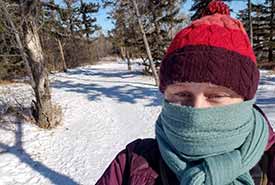
Dressed for birding in the polar vortex (Photo by Sarah Ludlow/NCC staff)
The Great Backyard Bird Count (GBBC) is a global community science project that aims to gather a snapshot of bird populations and distributions in mid-February, before their annual spring migrations begin.
The GBBC runs for four days each year, typically the second weekend in February. This year (2021) marks the 24th anniversary of the event and the 13th year that I’ve participated.
Because the GBBC is a community science initiative, it provides a volume of data that would be impossible for scientists to collect by themselves. Scientists use the GBBC data to look at trends in bird numbers between years, document changes in range size, and gain insight into how birds are affected by environmental changes.
As the project name suggests, birds can be counted in your backyard or anywhere you’d like to go to observe them. The GBBC is a great and easy way to help bird conservation in your local community. It is also an excellent example of how even seemingly small actions (like a single bird count from your backyard) can make a big difference.
I live in Regina, and the weekend of this year’s GBBC was held in typical Arctic-like temperatures and frigid winds that characterize the province in winter. However, I didn’t let the weather deter me.
This year, I submitted checklists for birds from four different locations. Perhaps one main advantage of a backyard bird count is that you can literally sit in your living room and count the birds you see out the window. I definitely did this, and over the course of the four days, I documented four different species in my yard or at my bird feeders: red-breasted nuthatch, black-capped chickadee, house sparrow and common raven.
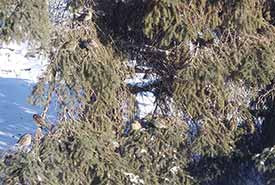
House sparrows fluffed up to stay warm (Photo by Sarah Ludlow/NCC staff)
On Sunday, I went to my parents’ farm, about 40 kilometres from Regina, to help with some chores and, while there, I made sure to count the birds that I saw. I saw more species at the farm than in my city backyard, likely because the farm has a greater diversity of habitats. I documented seven different species at the farm, either at the bird feeders or around the yard: red-breasted nuthatch, black-capped chickadee, house sparrow, downy woodpecker, dark-eyed junco, common redpoll and black-billed magpie.
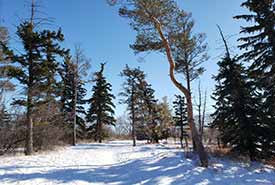
A.E. Wilson Park, SK (Photo by Sarah Ludlow/NCC staff)
On Monday, I ventured to two different parks within the city — A.E. Wilson and Les Sherman. A.E. Wilson park has two islands in a wide spot in the creek, one that was planted with trees decades ago and the other was meant to be a prairie grassland but is unfortunately mostly weeds now. Both are ringed with riparian shrubs. I was mostly interested in investigating the treed island, but I did walk around both.
The prairie island was very windy and exposed (wind chill that day felt like -31 C), which is likely why I didn’t see any birds there. The forested island was a more pleasant walk and much more fruitful in terms of seeing birds. I saw five different species: red-breasted nuthatch, black-capped chickadee, house sparrow, dark-eyed junco and black-billed magpie. I saw many of the same species at A.E. Wilson park as I did at my parents’ farm and this is due to habitat similarities between the two places, mainly the presence of naturally occurring or planted trees. This shows that you don’t necessarily have to travel very far from home to be able to see a variety of bird species.
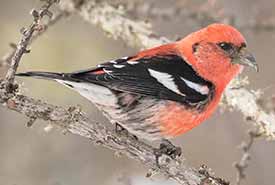
White-winged crossbill male (Photo by Bryan Calk)
The reason I chose A.E. Wilson park is because it is a reliable place to spot birds in any season due to the variety of habitats it contains. The reason I went to Les Sherman park was a bit more targeted. I went there to see if I could find the white-winged crossbills that had been sighted there the previous day through my ebird alerts (I signed up for notifications of rare birds in the Regina area). I did not have any luck on my quest for the crossbills, despite checking every single spruce tree, and ended up taking another cold and windy walk that almost resulted in no birds. Fortunately, I did come across two other bird species at Les Sherman park — house sparrows and pigeons — as well as about half a dozen white-tailed jackrabbits. Crossbills are somewhat renowned for their erratic nature due to their constant pursuit for spruce cones that feed their flocks; so, although it was disappointing that I did not find the crossbills, it was not surprising.
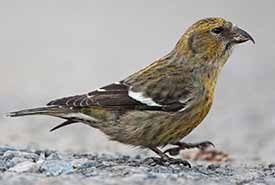
White-winged crossbill female (Photo by Chris Wood)
Overall, I counted 123 individuals of eight different species over the four days of the GBBC this year. The official results from the GBBC are typically published mid-March and can be found on the GBBC website.
Even though most of the species I encountered would be considered common and among the usual suspects for winter birds in Saskatchewan, I think it was a huge success because documenting the presence and abundance of the ”boring” birds is what helps keep common birds common.
Also, it is by walking the usual trails and going to the usual places to see the species you’d expect to see there, that you find the ones you don’t expect to. And this is one of the things I like most about the GBBC; the emphasis on documenting what is there simply because it is and not only trying to capture what is rare — truly every count matters and every bird counts!
If you didn’t have the opportunity to participate in the Great Backyard Bird Count this year, don’t worry! It is an annual event and you can contribute next year between February 18 and 21, 2022.


